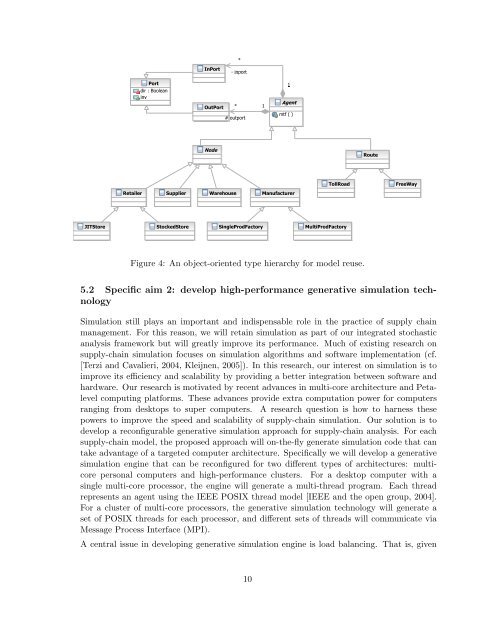SimRisk: An Integrated Open-Source Tool for Agent-Based ...
SimRisk: An Integrated Open-Source Tool for Agent-Based ...
SimRisk: An Integrated Open-Source Tool for Agent-Based ...
You also want an ePaper? Increase the reach of your titles
YUMPU automatically turns print PDFs into web optimized ePapers that Google loves.
Figure 4: <strong>An</strong> object-oriented type hierarchy <strong>for</strong> model reuse.<br />
5.2 Specific aim 2: develop high-per<strong>for</strong>mance generative simulation technology<br />
Simulation still plays an important and indispensable role in the practice of supply chain<br />
management. For this reason, we will retain simulation as part of our integrated stochastic<br />
analysis framework but will greatly improve its per<strong>for</strong>mance. Much of existing research on<br />
supply-chain simulation focuses on simulation algorithms and software implementation (cf.<br />
[Terzi and Cavalieri, 2004, Kleijnen, 2005]). In this research, our interest on simulation is to<br />
improve its efficiency and scalability by providing a better integration between software and<br />
hardware. Our research is motivated by recent advances in multi-core architecture and Petalevel<br />
computing plat<strong>for</strong>ms. These advances provide extra computation power <strong>for</strong> computers<br />
ranging from desktops to super computers. A research question is how to harness these<br />
powers to improve the speed and scalability of supply-chain simulation. Our solution is to<br />
develop a reconfigurable generative simulation approach <strong>for</strong> supply-chain analysis. For each<br />
supply-chain model, the proposed approach will on-the-fly generate simulation code that can<br />
take advantage of a targeted computer architecture. Specifically we will develop a generative<br />
simulation engine that can be reconfigured <strong>for</strong> two different types of architectures: multicore<br />
personal computers and high-per<strong>for</strong>mance clusters. For a desktop computer with a<br />
single multi-core processor, the engine will generate a multi-thread program. Each thread<br />
represents an agent using the IEEE POSIX thread model [IEEE and the open group, 2004].<br />
For a cluster of multi-core processors, the generative simulation technology will generate a<br />
set of POSIX threads <strong>for</strong> each processor, and different sets of threads will communicate via<br />
Message Process Interface (MPI).<br />
A central issue in developing generative simulation engine is load balancing. That is, given<br />
10




